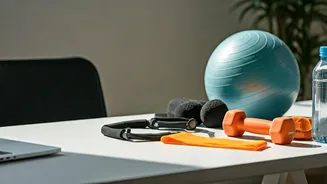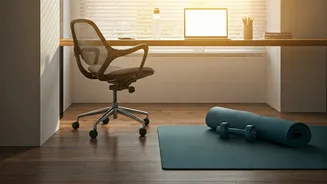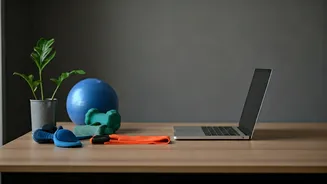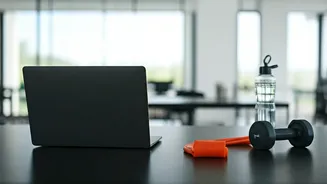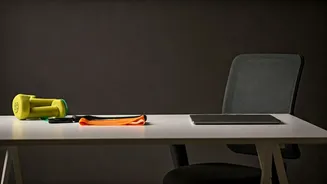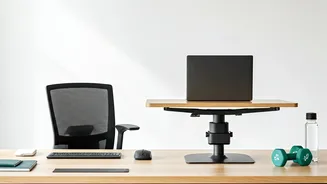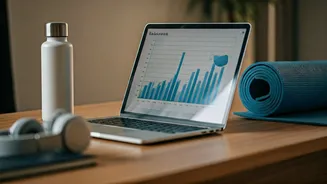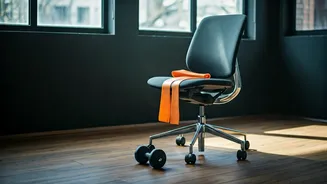Oblique Twists: Core Strength
Oblique twists are a fantastic exercise that can be easily incorporated into your workday. To perform them, sit upright in your chair with your feet flat
on the floor. Place your hands behind your head, ensuring your elbows are out to the sides. Now, twist your torso to the right, bringing your right elbow towards your left knee. Return to the center and then twist to the left, bringing your left elbow towards your right knee. Repeat this twisting motion for a set number of repetitions. Oblique twists primarily target your obliques, the muscles along the sides of your abdomen, helping to strengthen your core and improve posture. Regular practice can enhance core stability, which in turn supports spinal health, preventing back pain that often accompanies prolonged sitting. Furthermore, the twisting motion itself encourages better circulation, combating the negative effects of a sedentary lifestyle. Incorporating oblique twists offers a quick, efficient way to integrate fitness into the office routine. Remember to maintain a controlled pace and focus on engaging your core muscles for optimal results.
20-20-20 Rule: Eye Relief
The 20-20-20 rule is an incredibly simple yet effective method to combat eye strain, a common issue for those who spend hours staring at screens. The principle is straightforward: every 20 minutes, look away from your screen and focus on an object that is 20 feet away for 20 seconds. This brief pause allows the eye muscles to relax, preventing eye fatigue and reducing the likelihood of headaches. To put this into practice, set a timer to remind you to take these breaks. Look for an object that is easily visible from your workstation, like a window, a tree outside, or a distant wall decoration. When the timer goes off, shift your gaze to that object, fully focusing on it for the required 20 seconds. This action prevents digital eye strain and provides a mini mental break, which can boost productivity and well-being. Implement this rule consistently throughout your day for a significant improvement in eye health and overall comfort.
Calf Raises: Leg Circulation
Calf raises are a straightforward exercise that can be performed without any equipment, offering an excellent way to activate your lower leg muscles and boost circulation, which can be particularly beneficial for those who sit for extended periods. To perform calf raises, begin by sitting in your chair with your feet flat on the floor. Slowly lift your heels off the ground, rising onto your toes. Hold this position briefly, then gently lower your heels back to the floor. Repeat this movement for a set of repetitions. This exercise targets the calf muscles (gastrocnemius and soleus), improving their strength and endurance. Regular calf raises promote blood flow throughout the lower legs, combating the pooling of blood that can occur with prolonged sitting, thus reducing the risk of swelling and discomfort. Doing calf raises can counter the stiffness often associated with inactivity, enhancing your overall lower body well-being. You can also do them standing if you want a more challenging exercise. Incorporate this easy exercise into your daily routine by setting reminders or timing it with other tasks.
Leg Marches: Leg Activity
Leg marches are a simple exercise that can improve your leg muscles without leaving your chair. To perform this exercise, sit upright in your chair, keeping your back straight and your feet flat on the floor. Lift one knee towards your chest, holding it for a few seconds before returning your foot to the floor. Repeat this with the other leg, alternating between right and left. Maintain a controlled pace throughout the exercise. Leg marches effectively engage your hip flexors and quadriceps, promoting blood circulation in your legs and enhancing muscle strength, which can help offset the inactivity of long workdays. This exercise also improves flexibility in your hips and thighs. Consistent practice helps boost the health of the lower body. For added benefit, try increasing the speed or duration of the exercise. Leg marches are adaptable and require minimal space or equipment, making them an excellent choice for a quick office workout.
Breathing Exercises: Calm Down
Breathing exercises are a powerful tool for reducing stress and increasing focus, making them an ideal addition to your office routine. These exercises are easy to do and can be practiced anytime, anywhere. One simple technique is deep breathing: Inhale slowly and deeply through your nose, allowing your abdomen to expand. Hold your breath for a few seconds, then exhale slowly through your mouth, emptying your lungs. Repeat this several times. Another method is box breathing: Inhale for a count of four, hold for four, exhale for four, and hold for four, creating a box-like pattern. Breathing exercises activate the parasympathetic nervous system, triggering the body's relaxation response. They lower the heart rate, reduce blood pressure, and decrease feelings of anxiety. By incorporating these exercises into your workday, you can promote a sense of calm, manage stress, and enhance mental clarity. Take short breaks to practice these breathing techniques. Consistent practice can lead to a more balanced and focused state of mind, improving both your productivity and your overall well-being.
